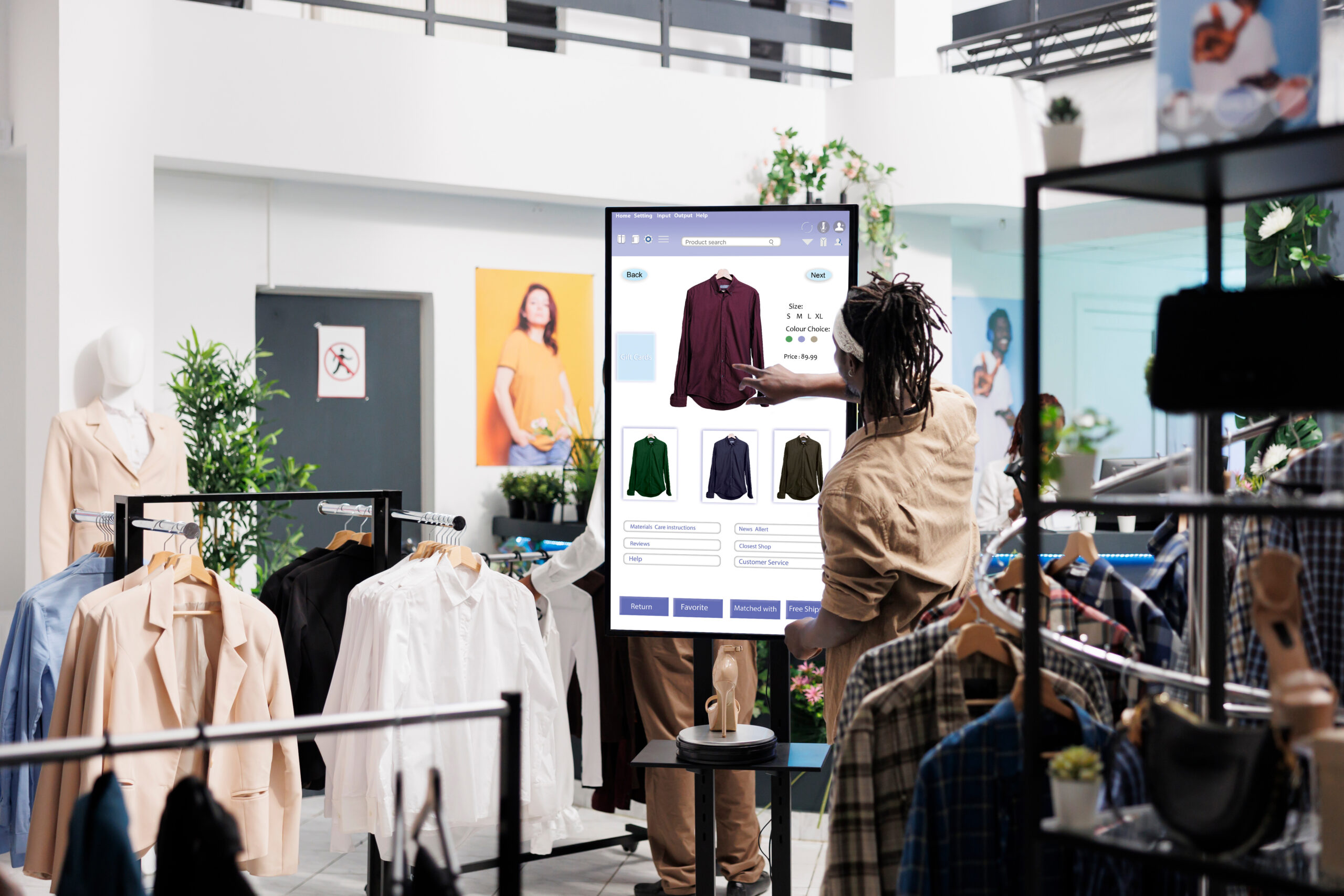“They (Shoppers) expect stores to be digitally enabled and for brands and retailers to support hybrid shopping journeys, which blend physical and digital channels” (IBM Consumer Research.)
Interactive in-store displays are transforming the retail industry. By fusing digital technology with traditional retail displays provides a tailored shopping experience that captivates customers. These displays empower consumers, facilitating well-informed purchasing decisions and fostering a strong connection between product, brand and consumer. This article focuses on the significance of interactive in-store displays and their far-reaching implications for the retail landscape.
“72% of consumers rely on physical stores as all or part of their primary shopping method.” (IBM and the NRF)
What are Interactive In-Store Retail Displays?
In-store interactive displays are digital presentations strategically positioned within a retail environment. These displays engage shoppers through interactive interfaces such as touchscreens, videos, and social media integrations.
The combination of digital innovation within physical retail spaces offers consumers a sensory-rich experience, enabling them to engage directly with products, gather information, and even share their experiences on social platforms.
What is the Aim of Interactive Retail Displays?
Interactive displays revolutionize the shopping experience and enhance retail outcomes. The interactive quality captivates customers and encourages them to explore products more deeply. The multi-sensory nature of the experience appeals to tactile engagement and helps shoppers make informed decisions.
Additionally, these displays serve as tools for seamless omnichannel marketing, guiding customers toward purchases and creating lasting brand impressions. In effect, these displays elevate foot traffic, sales, and customer loyalty while offering retailers a dynamic way to adapt to the evolving retail landscape.
How have Interactive Displays Impacted the Retail Industry?
According to a report by Grand View Research, the global smart retail display market size was valued at $7.88 billion in 2020 and is projected to reach $20.61 billion by 2028. In addition, consumer survey studies by several marketing research firms have found:
- 87% of shoppers would shop more in person if stores had interactive screens that provide product information, comparisons, and reviews. (Reflect)
- 83% of shoppers believed interactive displays were effective in helping them make purchase decisions. (Retail TouchPoints)
- 71% indicated they were more likely to visit a store featuring interactive experiences. (Retail TouchPoints)
- 63% of consumers reported that digital signage influenced their purchasing decisions. (Intel)
- Interactive displays can increase sales by up to 30%. (Intel)
Which In-store Interactive Displays Are Most Effective?
Below are currently the most utilized interactive displays in the retail industry. The effectiveness of the display type depends on the brand and product promotion:
Interactive Touchscreen Kiosks
Interactive touchscreen kiosks are effective in-store displays because they empower customers to control their shopping experience. A consumer study by Mvix Digital Signage found that digital displays are 48% more effective at spreading brand awareness and 400% more capable of capturing attention than static displays.
Interaction with displays allows customers to explore products, view promotional materials, and access information at their own pace; these kiosks provide a personalized shopping journey. For instance, fast-food chains use touchscreen kiosks for self-service ordering, enhancing convenience and customization.
Dynamic Digital Displays
Digital displays optimize store space by presenting a single product at a time on screens, eliminating the need for excess inventory on shelves. This strategy creates a visually appealing and organized environment while offering customers a more comprehensive selection of products through digital browsing. And, dynamic digital displays are particularly valuable in industries like beauty and cosmetics, where displays can showcase how products complement each other.
Interactive Packaging Displays
Interactive packaging displays engage customers with product information and enhance brand recall. Incorporating interactive elements on packaging allows brands to create a unique experience that captures customers’ attention and reinforces brand narratives.
These displays are especially effective in increasing product recognition and providing consumers with memorable interaction, driving product recall and loyalty. Examples of interactive packaging include:
- Pizza Hut: Dual-Purpose Packaging marries food and entertainment
- Tic Tacs: Tweet-Activated Snack Machines trade tweets for potato chips
- Coca-Cola: EKOCENTER improves life with water purifying kiosks
- Lay’s Chips: Lay’s Partners with Uber for a potato chip delivery promotion
- Twizzlers: Caramel-Stuffed Licorice with candy apple filling delights Twizzlers-fans
Versatile Promotion Displays
Interactive retail displays with versatile promotion capabilities enable retailers to adapt to changing marketing campaigns and seasons. These displays can easily adjust the layout and messaging to align with current promotions, exposing customers to fresh content.
Educational and Informative Displays
Interactive displays that offer educational content provide valuable information without overwhelming shoppers. Customers can learn about products and make informed decisions while enjoying a seamless shopping experience. Presenting information interactively and engagingly improves customer satisfaction and increases the likelihood of conversion.
QR Code Integration Displays
Integrating QR codes into displays creates an omnichannel experience, allowing customers to transition between physical and digital interactions. QR codes provide convenient access to additional information, ongoing campaigns, and promotions through smartphones.
Deloitte’s Navigating the New Digital Divide report found that 34% of shoppers will use their digital resources (namely smartphones) while shopping in person. The QR code approach extends customer interaction beyond the physical store and contributes to a consistent brand experience across different channels.
In short, incorporating interactive retail displays can revolutionize the in-store experience, offering customers personalized interactions, enhancing engagement, optimizing space, boosting sales, improving brand recall, and adapting to evolving marketing strategies.
“Consumers no longer see online and offline shopping as distinct experiences—they expect everything to be connected all the time.” (IBM Consumer Research.)
Interactive retail displays are not just the future; they are present-day essential tools for successful retail operations. The interactive nature of these displays provides a unique shopping experience that is both engaging and informative, dramatically influencing consumers’ buying decisions.
When retailers adopt interactive display technology, they can deliver a seamless combination of the digital and physical worlds, enhancing customer satisfaction and loyalty. The integration of such displays can result in higher sales, improved brand positioning, and a dynamic edge in the competitive retail market.
Thank you for reading our article! TimeWellScheduled is a secure online time and attendance software 100% tailored to meet your employee scheduling needs! In addition, our cloud-based solution facilitates attendance tracking and payroll processing and enhances workforce management capabilities. Plus, our service is free for up to 10 employees.






